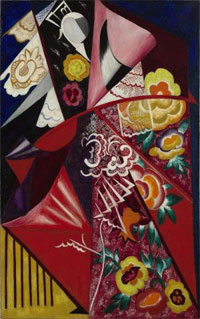 Art, and a Russian revolution
Art, and a Russian revolutionSoviet and modern Russian paintings are in demand at auctions across the world
Sunday, 25 April 2010
CHRISTIE'S IMAGES LTD
Natalia Goncharova, who died in 1962, was already the highest selling female artist at auction when Espagnole, painted during the First World War, sold in February for £6.4m. It beat her previous record of £5.5m set for Les Fleurs, sold in 2008
The Russians are coming. The multi-million pound herd of buyers who stampede around the world in pursuit of the art market's "next big thing" is rushing this weekend to buy into what they hope will be the latest bubble: Russian art
Auctioneers in Manhattan shifted more than 600 works from the former Soviet Union in just two days of what is being described as a "Russian tidal wave".
The surge is partly thanks to the economic downturn which has seen the volume of work sold by the relatively cheaper artists soar.
Last year it was Chinese and Indian art that was on the up – and sales are still strong as an auction in Hong Kong saw earlier this month.
Old Masters also made a comeback thanks to the economic downturn – which paradoxically saw Rubens and Rembrandt achieve record prices in December. Analysts say Old Masters are a sure bet in volatile times because their enduring value is proven over centuries.
The money moved to Old Masters after the bottom fell out of the contemporary art at the end of 2008. Before that, there was frenzied jostling for works by Damien Hirst or Jeff Koons. In 2007, the record price paid for a living artist at auction changed three times – going first to Lucian Freud's portrait of Bruce Bernard, then Damien Hirst's pill cabinet, Lullaby Spring and then to Jeff Koons's Hanging Heart. In 2008 it switched again when Roman Abramovich bought Freud's Benefits Supervisor Sleeping for £17.2m.
The super wealthy were all paying silly prices for Impressionist paintings in the middle of this decade, culminating in the £40m paid for Monet's Le Bassin Aux Nymphéas in 2008.
Post-war works by the likes of Rothko and Francis Bacon have also been in demand. And there have been fads for Gustav Klimt and Canaletto, while Giacometti's stock rose, culminating in a world record £65m for his life-size bronze sculpture of a man, auctioned in February.
There are some artists, however, who have held steadily throughout the past 10 years. Both Picasso and Andy Warhol have consistently been among the top sellers since 2002.
Rocketing prices for Russian works was reflected in the sale of Natalia Goncharova's Espagnole. It cemented her place as the world's highest selling female artist, fetching £6.4m at a Christie's sale in London in February. Two months earlier, London sales of Russian art totalled almost £40m.
This weekend in New York, records for relatively unknown artists such as Nicolas Kalmakoff and the Ukrainian Pavel Tchelitchew tumbled. ArtPrice, an auction tracking organisation, described the sales simply as a "Russian tidal wave".
Works from China, Brazil and India are also beginning to make an impact on the international market as newly wealthy entrepreneurs from emerging economies look to invest in art.
A sale at London's Saatchi Gallery saw a work by the Russian Erik Belated top its inaugural Bric – Brazil, Russia, India and China – sale. And in Hong Kong earlier this month more than 2,400 lots of Chinese art made £166m.
A report by ArtPrice on art sales between 2005 and 2008 says: "The number of Russian artists generating seven-figure sums dramatically increased as wealthy collectors exercised an appetite for a new body of work that was relatively cheap compared to the stratospheric prices being fetched by European art. After an increase of 473 per cent between 1998 and 2008 prices contracted in 37 per cent with the crisis.
"In April 2010, rather than betting on seven figure results, Sotheby's and Christie's have decided to offer a vast range of works by well-known artists with low estimates."
Ed Dolman, Christie's chief executive for the Middle East, Russia and Asia said that new wealthy buyers were coming from these areas. They begin buying their own heritage, before branching out into more general art.
"The value bought by Chinese buyers worldwide in Christie's sales increased by 94 per cent in 2009," he said. "Russian buyers spent less than in 2008 across all departments, but the number of lots they bought increased by 13 per cent. In addition, registrations from the clients in the Middle East increased by almost 30 per cent, the highest increase of any geographic region."
2002: Massacre of the Innocents, Rubens
Rubens gatecrashed the dominance of the Impressionists when the Massacre of the Innocents sold for a then record £49.5m
2003: L'Allée des Alyscamps, Van Gogh
Van Gogh was in vogue with £30m worth of art sold, the most after Picasso. This work sold for £6.6m
2003: Maternité, Gauguin
Impressionism is riding high and Gauguin's Maternité sold for £22m
2005: The Grand Canal, Canaletto
Modernists were making their mark, but several Canaletto sales – this went for £16.6m – saw the artist jump from 238th to 4th place
2006: Birch Forest, Klimt
Klimt's year, thanks to four Nazi-looted works being returned to their owners and sold – this for £26m
2007: Lullaby Spring, Hirst
Contemporary artists are top and records tumble. Damien Hirst was briefly the most expensive living artist at auction when this sold for £9.6m
2008: Benefits Supervisor Sleeping, Freud
The art market bubble burst this year, but Roman Abramovich still had a spare £17.2m to make Lucian Freud the most expensive living artist
2009: Fisherman, Qi Baishi
Baishi is one of the new Chinese stars. This sold for £153,000
 Art, and a Russian revolution
Art, and a Russian revolution